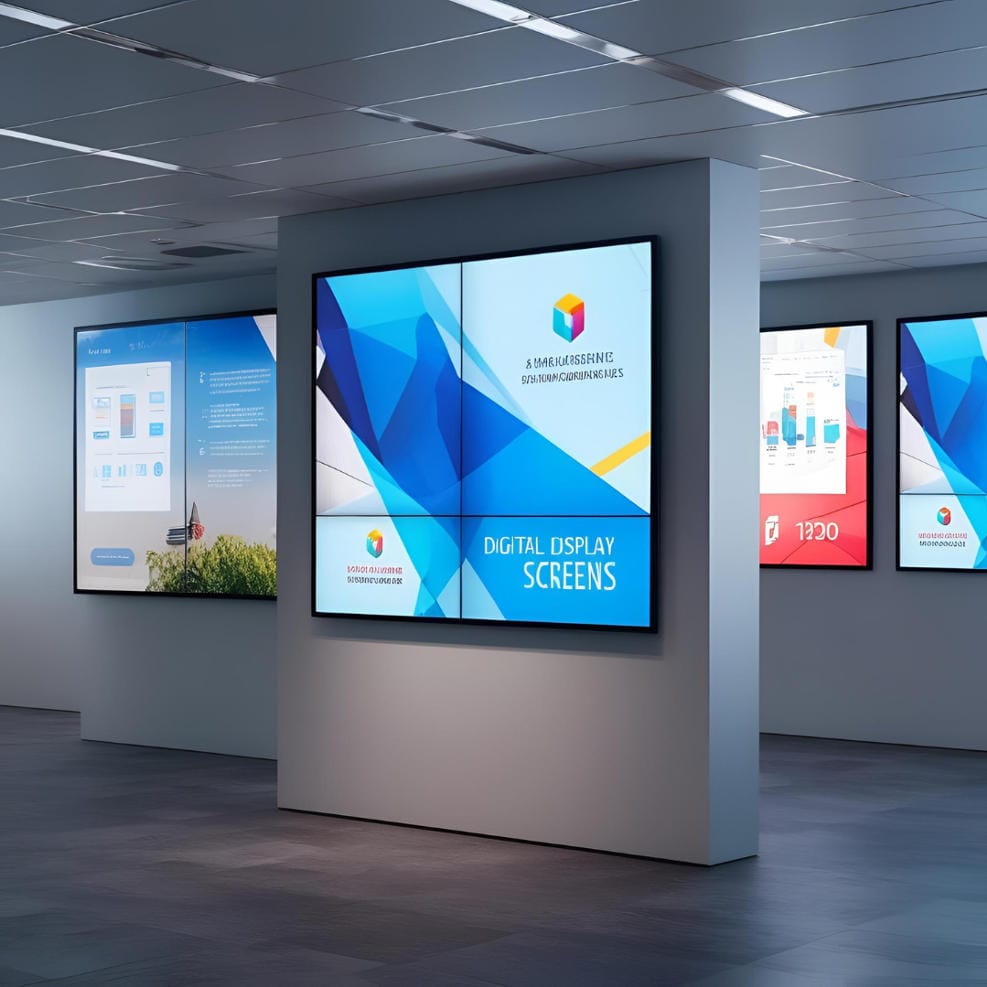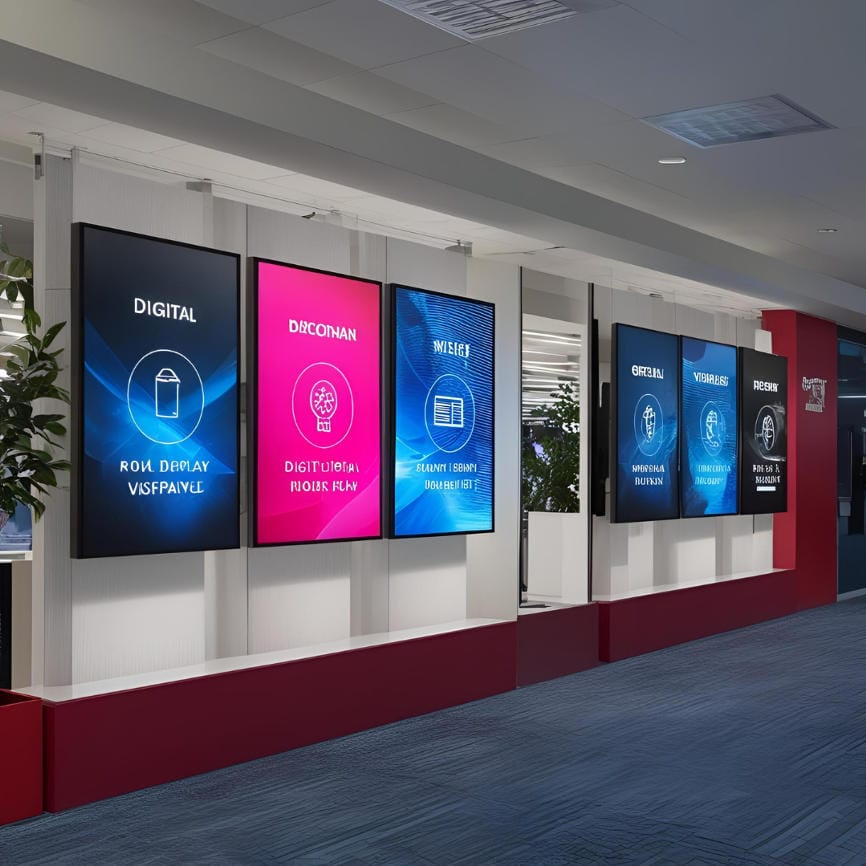The Evolution of Passenger Information
Digital display screens have revolutionized information-sharing processes in retail businesses as well as educational institutions, transportation systems, and corporate facilities. The modern digital display technology provides flexible operation with live content delivery, which beats static signage in every way. Businesses that choose digital display systems need to grasp fundamental requirements before purchasing to achieve maximum investment value.
 Understanding Digital Display Screens
Understanding Digital Display Screens
Digital display screens represent electronic screens that show moving content, such as videos, along with images, text, and interactive aspects. The multiple screen technologies, which consist of LED LCD and OLED, provide distinct advantages for different environmental and usage requirements.
Digital displays now serve all applications from office requirements to teaching needs, thus transforming static signs into dynamic electronic systems. These screens operate through content management systems, which enable remote control capabilities, thus making them an efficient solution for multiple business sectors.
Benefits of Using Digital Display Screens
Digital screen displays provide better benefits than traditional signage through their enhanced features.
Dynamic Content
Digital displays provide businesses with the capability to display new content at any time, which helps them execute quick changes to their promotions or business updates.
Cost Efficiency
Digital displays cut down the recurring expenses of printing materials because they eliminate the need for physical updates. The long-term financial benefits become substantial because of this method.
Improved Engagement
The audience stays active because digital displays implement motion graphics and video elements as well as real-time updates. Such technology enables viewers to experience an interactive modern format.
Remote Management
Through central management systems, businesses can shop for a variety of content across their outlets while saving time and money.
Eco-Friendly
The digital signage system creates environmental benefits through its paperless operation, which helps reduce waste.
Types of Digital Display Screens
The selection of digital display screens depends on specific usage requirements between different variants.
LCD (Liquid Crystal Display)
LCD screens are primarily used indoors because they deliver clear images with energy-efficient operation. Such displays work best when maximum brightness is not essential for the environment.
LED (Light Emitting Diode)
The bright LED technology consumes minimal energy while functioning well inside and out, particularly when used in large public areas.
OLED (Organic LED)
OLED screens provide thin profiles and superior image contrasts, which makes them ideal for premium applications built in confined spaces.
Touchscreen Displays
Interactive digital displays serve as effective tools for retail engagement with customers while they also work as kiosks that provide service directories in public areas.
Projection Displays
The technology enables affordable large-scale presentations in theaters through projection display systems.
 Choosing the Right Digital Display Screen for Advertising
Choosing the Right Digital Display Screen for Advertising
Multiple elements need evaluation when selecting digital display screens for advertising purposes.
Location
The placement location between inside and outside must be determined before moving forward. Fighting weather elements require outdoor displays to have durable characteristics.
Screen Size
Big screens attract a lot of attention, although they come at higher costs. The available space, together with how far away viewers will be, should guide your selection.
Resolution
Full HD, along with 4K resolution, makes content appear sharp and detailed precisely when you need to show detailed images or videos.
Brightness
When using outdoor digital display screens, select models with brightness levels exceeding 2,500 nits to achieve visibility under bright sunlight conditions.
Scheduling
Your digital display should operate promotional content according to scheduled times to deliver timely and appropriate messages.
Selecting a Digital Display Screen for Office Use
Office digital displays serve three primary functions: better communication pathways, route guidance, and process optimization. Several important attributes should be taken into account when making a choice.
Wall-Mounted vs. Freestanding
Your office space determines which display setup you need to select. Office space demands two options for digital displays: wall-mounted screens require less space, but freestanding units provide adaptable setups.
Integrated Scheduling
Sync your digital display with office calendars for meeting room management.
Split-Screen Capabilities
Sending concurrent visual content increases operational speed, particularly during real-time information delivery or notification tasks.
Video Conferencing Support
Modern displays can perform video conferencing capabilities, which makes them valuable tools for conducting hybrid work from home.
Using Digital Screen Displays for Teaching
Education has undergone transformation through digital displays, which produce interactive education environments that engage students. Digital signage technology offers several benefits to teaching as an educational tool.
Interactive Screens
The educational content becomes accessible to students for interactive involvement through the use of interactive maps and live polling features.
Content Flexibility
Educational content should include PDFs along with videos and live-stream media so students can choose their preferred learning format.
Remote Learning Integration
Online teaching platforms should integrate digital signage to offer students easy access to educational content and system updates with easy access to assignments.
Durability
Rugged displays should be selected for high-traffic areas because they are built to survive frequent usage alongside handling.
Eye-Care Features
Students benefit from eye-care technologies and anti-glare screens that defend their vision during long periods of screen viewing.
Installing Outdoor Digital Display Screens
Digital outdoor displays need extra attention because they operate under outdoor weather conditions. Key features include:
Weatherproof Enclosures
Weatherproof cases must be used to protect screens from rain while preventing dust and humidity from reaching them.
Temperature Regulation
The built-in cooling or heating systems on certain outdoor display products enable their operation in extreme temperature conditions.
High Brightness and Anti-Glare
Displays with high-bright technologies and anti-glare applications should be chosen for clear outdoor visibility during daytime conditions.
Strong Mounting Systems
The installation of secure hardware systems becomes essential because wind-related threats and vandalism incidents need protection.
Remote Diagnostics
Remote performance monitoring allows users to check outdoor screen functionality without physically visiting the site.
Screen Size, Resolution, and Viewing Distance
The decision about screen dimensions and resolution choices directly influences both picture quality and visual impact. Consider the following:
Small Rooms or Offices
Small areas should use screens with Full HD resolution in dimensions ranging from 32 to 55 inches to achieve maximum visibility.
Large Conference Rooms or Classrooms
Screens with measurements between 65 to 85 inches that deliver 4K resolution allow viewers to read content from across the room.
Outdoor Billboards
When using screens for outdoor billboards, one should use large displays while keeping pixel density low since viewers will stand at a distance.
Rule of Thumb for Size
The screen dimension formula requires dividing the measurement of viewing distance by 1.5.
Power, Connectivity, and Mounting Options
Installation proceeds smoothly when the system receives its power requirements and maintains correct connectivity.
Power Supply
The screen needs to operate on the local voltage standards while also having backup power available through UPS systems.
Connectivity Options
Assess all possible connection options, including HDMI, USB, Wi-Fi, and Ethernet.
Cable Management
The installation remains clean when cables receive proper management through the use of conduits or trucking.
Mounting Options
Select an adequate mounting system that suits your environment because you can choose between wall mounts, ceiling mounts, and floor stands.
 Software and Content Management Systems (CMS)
Software and Content Management Systems (CMS)
Content management requires the CMS operating system to function behind the display. Several essential functionality features should exist for consideration during selection.
User-Friendly Interface
The CMS system needs to have an interface that non-technical users can easily understand.
Template Support
The system enables users to select from different pre-made templates that help create content efficiently.
Scheduling Tools
The update of content should be planned in advance so that manual edits become unnecessary.
Multi-User Access
Multiple users managing content will get secure access through distinct permission levels.
Analytics
Your strategy optimization requires tracking content performance followed by data collection for strategic improvement.
Budgeting for a Digital Display Installation
The success of any installation project starts with proper budget planning. Consider the following costs:
Screen
The pricing starts at $200 for indoor displays that measure small and extends to $20,000+ for outdoor LED displays that are large.
Mounting and Cabling
The total expenses for mounting along with cabling installation start at $100 and increase up to $1,000, depending on how complex the setup becomes.
Software Licensing
CMS platform software comes with either recurring monthly payments or a single payment at purchase.
Labor Installation
Costs for labor installation depend on the location and project difficulty, thus requiring budgeting for this expense.
Maintenance Contract
The purchase of optional maintenance contracts includes updates and support services through regular maintenance.
Maintenance and Durability Considerations
The following factors should be considered for achieving long-term reliability:
Regular Cleaning
Non-abrasive materials should be used to cleanse screens to keep them clear.
Software Updates
The system will operate smoothly by maintaining updated CMS and firmware versions.
Remote Diagnostics
Systems that enable remote performance monitoring should be your selection.
Warranties
Shopping for displays requires checking for warranties that cover both parts and labor for 2-5 years.
Legal and Safety Regulations
Make certain you adhere to both local laws and regulations before starting with the installation process.
Permits
Before installing outdoor screens, local authorities must grant permits.
ADA Compliance
The establishment should provide complete accessibility through braille communication alongside wheelchair pathways and audio assistance.
Fire Codes
All electrical systems and fire protection guidelines must be followed.
Building Regulations
For installations in commercial or historical buildings, check compliance with zoning laws.
Future-Proofing Your Investment
These conditions for digital display investments need examination because technology will progress swiftly in the upcoming years:
Modular Design
Through modular construction, users get the advantage of maintaining system operations while updating individual parts.
Open Software Standards
Open software standards in your system selection will help you avoid vendor lock-in situations.
Remote Control Capabilities
Users can operate and manage various displays through remote control access from any location.
Frequently Asked Questions (FAQ)
What is the best digital display screen for office communication?
The optimal display for office communication consists of LED or LCD technology, which includes built-in content scheduling features and video conferencing capabilities.
Can I install a digital display screen outside without a cover?
Standard outdoor screens need protective weatherproof enclosures together with temperature control systems to survive environmental conditions.
How long do digital display screens last?
The lifespan of commercial-grade screens extends from five to ten years when users provide appropriate maintenance.
What size screen do I need for a classroom?
Clear visibility requires classroom screens to measure between 65-85 inches.
Do I need internet to use a digital screen display?
The display of local content functions offline, but real-time updates and remote management need an active internet connection.


 Understanding Digital Display Screens
Understanding Digital Display Screens Choosing the Right Digital Display Screen for Advertising
Choosing the Right Digital Display Screen for Advertising


